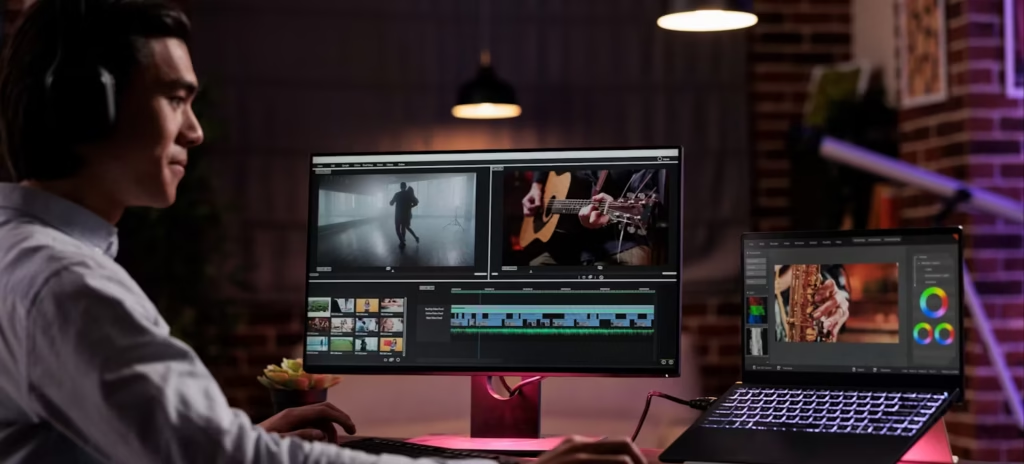
The Future of Graphic Design: Will AI Replace Designers?
Introduction: The Rise of AI in Creative Fields
The Future of Graphic Design: Will AI Replace Designers? The rise of artificial intelligence (AI) has disrupted nearly every industry — from healthcare and finance to education and marketing. Now, it’s knocking on the doors of the creative world. In particular, the graphic design industry is undergoing a significant transformation as AI-powered tools become more advanced and accessible.
Today, AI can generate visuals, logos, templates, and even entire branding kits with just a few prompts. This has sparked a growing concern among designers and creatives: Will AI replace graphic designers altogether? Or is there still a place for the human touch in a world of machine-generated visuals?
This blog explores the current state of AI in design, its capabilities and limitations, and what the future holds for designers who want to stay relevant in this changing landscape.
AI in Graphic Design: What’s Already Happening
AI is no longer a futuristic concept — it’s already embedded in the everyday tools designers use. Applications like Canva, Adobe Photoshop, Figma, and Adobe Firefly are incorporating AI to assist with design tasks that used to take hours. These AI features can automatically remove backgrounds, suggest layouts, match font pairings, and even write short-form content or captions.
Generative AI tools like Midjourney, DALL·E, and Runway ML can now create fully rendered images, illustrations, and concept art from simple text prompts. For example, typing “a futuristic logo for a tech startup” into an AI image generator can instantly produce a variety of high-quality options.
Even beginners with no design experience can create compelling visuals thanks to AI-enhanced design platforms. This democratization of design has raised concerns that professional designers might be pushed aside as businesses lean into fast, low-cost, AI-generated content.
The Future of Graphic Design: Will AI Replace Designers? What AI Can Do Well?
AI offers undeniable benefits in graphic design, particularly when it comes to speed, efficiency, and scalability. Tasks that used to take hours or even days can now be completed in minutes. For example:
- Template-Based Design: AI can generate consistent, on-brand templates for social media, presentations, or ads, saving time and effort.
- Automated Resizing and Formatting: AI tools can automatically resize designs for different platforms (Instagram, Facebook, LinkedIn, etc.) without manual adjustments.
- Smart Recommendations: Some tools suggest color palettes, fonts, or image placements based on current design trends or user behavior.
- A/B Testing: AI can quickly create multiple versions of an ad or graphic to test which performs best in real-time.
These capabilities make AI a powerful assistant for designers and a helpful shortcut for non-designers looking to produce visual content quickly and affordably.
What AI Still Can’t Do
While AI is a valuable tool, it still falls short in several key areas — particularly those that require human emotion, cultural sensitivity, and strategic thinking.
AI lacks the ability to truly understand context. It cannot grasp the deeper meaning behind a brand’s mission, voice, or story. It doesn’t know how to design for emotion, user experience, or cultural relevance. As a result, AI-generated visuals often feel generic or off-brand — especially when nuance and originality are required.
Additionally, AI can struggle with:
- Creative problem-solving: Designers often work with constraints (limited space, accessibility issues, brand guidelines). AI doesn’t innovate within those boundaries — it just generates outputs.
- Emotional storytelling: A human designer knows how to evoke specific emotions through imagery, color, and layout — AI does not.
- User experience design: In UX/UI design, understanding user behavior, accessibility needs, and human psychology is essential — AI can’t replicate this level of empathy or insight.
🎨 Designers are not just decorators — they are communicators, problem solvers, and brand strategists. AI still has a long way to go in replicating that complexity.
The Future of Graphic Design: Will AI Replace Designers? Not Exactly
The short answer is no — AI won’t replace graphic designers, but it will change the nature of the work they do.
Rather than eliminating the role, AI will redefine it. Routine or repetitive tasks — such as background removal, resizing, or generating mockups — will be handled by AI, freeing up human designers to focus on higher-level creative and strategic work.
Designers will increasingly shift from creators to curators and directors — using AI tools to generate raw ideas or visuals, then refining, editing, and aligning them with a specific brand vision or creative concept. The role becomes less about execution and more about interpretation, storytelling, and strategic guidance.
In short, AI is a powerful co-pilot — but designers are still in the driver’s seat.
The New Role of Designers in the AI Era
As AI becomes more integrated into the design process, the role of the designer will evolve. Here’s how:
1. Creative Strategist
Designers will need to think beyond visuals and focus more on brand strategy, user experience, and long-term creative direction. Instead of just making things look good, they will need to make them work well and feel right.
2. AI Collaborator
Designers must learn to work with AI tools — understanding how to prompt effectively, evaluate AI outputs, and refine them into final products. Just like Photoshop once became a required skill, AI literacy will be essential for modern designers.
3. Storyteller
In a world where visuals are easy to generate, storytelling becomes even more important. Designers must bring meaning, emotion, and narrative to their work — something AI can’t replicate.
4. Problem Solver
Complex design challenges — especially those involving diverse audiences or unique contexts — will always need human insight. Designers who can solve real business problems through design will remain in high demand.
How Designers Can Stay Relevant: The Future of Graphic Design: Will AI Replace Designers?
To thrive in an AI-powered future, designers should embrace lifelong learning and focus on human strengths that machines can’t replicate. Here are a few steps to stay ahead:
- Learn AI design tools like Adobe Firefly, Midjourney, and Figma AI features.
- Focus on soft skills such as empathy, communication, and client collaboration.
- Build strategic thinking — understand the business goals behind design decisions.
- Stay culturally aware — AI lacks understanding of cultural nuance and social context.
- Prioritize originality — create work that’s emotionally engaging, not just visually impressive.
🧠 Designers who combine creativity, strategy, and technical skills will not only survive — they’ll lead the future of the industry.
Conclusion: Creativity Can’t Be Replaced
AI is revolutionizing graphic design — but it’s not replacing designers. Instead, it’s changing how they work, what they focus on, and the tools they use. Rather than fearing AI, designers should embrace it as a creative ally — one that can enhance productivity, streamline workflows, and open up new possibilities.
At its core, design is about human connection — telling stories, evoking emotion, and solving problems. These are things that AI, no matter how advanced, simply cannot do alone.
The future of graphic design isn’t AI versus humans — it’s humans and AI working together to create smarter, faster, and more impactful design


